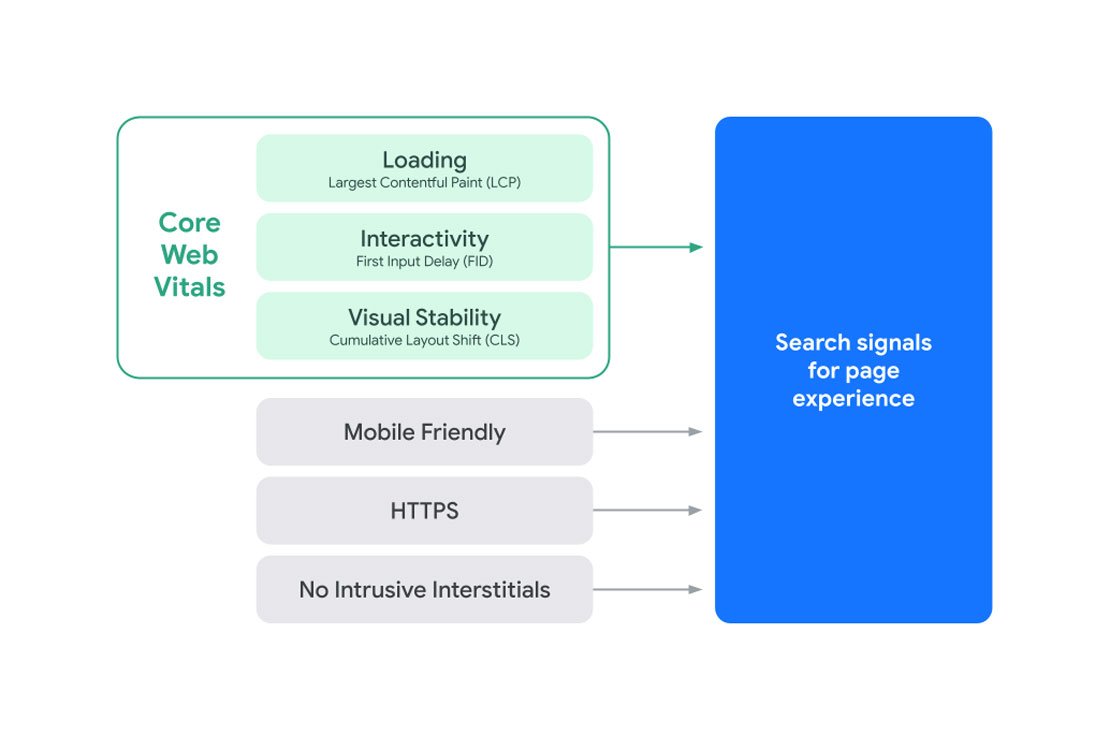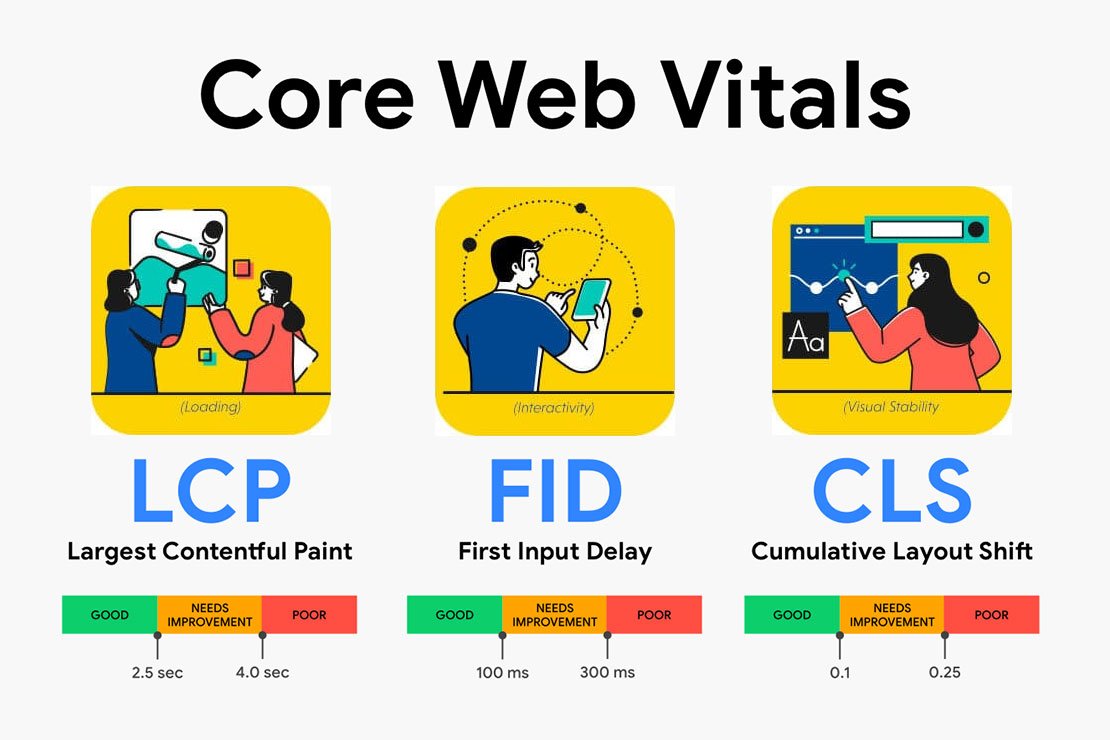Core Web Vitals
Get Your Website Ready for Google's Core Web Vitals Update
Do you need help to be in the top search results of Google? Consequently, you must know about Page Experience and its update.

Page Experience is what a user encounter while visiting a site. To rank it, Google assesses it in experience metrics like performance, visuals, stability, and compatibility.
However, Google keeps updating its algorithms to provide users with the best experience searching for information. Similarly, it ought to be improved by the new Google Page Experience Update.
The update includes a few changes in the past factors yet, in addition, presents new signals and calls it Core Web Vitals.
What Are Core Web Vitals?
The update incorporates new signals influencing the page insight and rankings on search engines.
Here is how Google mentioned its brand-new signals:
1. Largest Content Paint (LCP):
Call it the loading time of the website's main page, the homepage. Google observes how much time the webpage takes to load and rank it. If it takes longer to load, your webpage will lose rank and rank up if it loads faster.
By Google Standards, your website should load under 2.5 seconds and is considered a good website. This explains quite well that LCP should be under 2.5 seconds to be a good website and to be bad, LCP is above 4 seconds, as described in Google Standards. In between is the average performance website.

2. Cumulative Layout Shift (CLS):
It shifts images, content, and links on the webpage even after properly loading it. When the user clicks on a link/image, the user is directed somewhere else instead of the link user clicked. This results in frustrating the user, and Google doesn't like that this will derail your webpage.
According to Google Standards, the CLS score should be less than 0.1. If it's under 0.1, your webpage is good; above that falls to the average and poor website.
3. First Input Delay (FID):
FID is defined as how long a webpage responds when a user clicks a button. To achieve the best results, Google has mentioned an FID of less than 100ms (milliseconds). In other words, this metric observes a webpage's interactivity with a user.
These were the "brand-new" concepts introduced by Google in the recent update. Not only this, but Google also updated some previous metrics or called them signals. These updates are followed by:
Make Your Website Ready for The Core Vitals Update
These Google's Core Web Vitals briefly explain how a website should interact with visitors. You must take several actions to enhance your website page experience and offer your visitors a seamless user experience.
● Increase Your Website’s Speed
The need for speed is real in this fast-paced technological era since no one wants to wait for a sluggish website to load. Often users abandon websites that take a lot of time to load. So revamp your website's performance for more incredible speed.
To track your website's speed performance on Google's PageSpeed Insights and learn what is making it slow. Fulfill those spots and bumps causing your website to sputter and lose valuable seconds. With each tweak and adjustment, you're getting closer to that podium finish—where users are happy, and Google is impressed.
● Mobile-Friendly
Each of us owns a mobile phone and wants to access everything through our phones, whether it is a website or any application. Keeping this in mind, making a webpage mobile-friendly, Google will favor you for making it mobile-friendly and will improve its ranking.
When users access a website, it should interact with them in the same way it interacts on a desktop. However, there are tools designed by Google to test if a website is mobile-friendly or not.
Make your website scalable to adapt to any screen size to provide an exceptional user experience. Optimize images and other visual content to decrease loading time on mobile phones.
● Safe Browsing
It is as simple as it sounds that a website should be safe for browsing, without errors, harmful downloads or malware, or any deceptive links, links that cause multiple ads and tabs to pop up, redirecting to other irrelevant content (phishing).
Use SSL certificates on your website to stop hackers from breaking your site altogether. SSL is a protective layer to your website that hackers hate the most. It keeps your data safe while offering a seamless experience to your visitors.
● HTTPS Is The Key
Hypertext Transfer Protocol is the backbone of the internet that communicates with browsers. It wraps your website in a protective cloak, shielding it from data breaches, cyber-attacks, and unwanted snooping.
Upgrading HTTPS is essential to woo Google's heart and increase search engine rankings. This signal analyzes whether the website has an SSL certificate and whether the site's connection is via secure HTTPS or a non-secure HTTPS. Google will improve the website ranking if it qualifies to have an SSL certificate and secure HTTPS connection.
● No Intrusive Interstitials
These are the pop-ups upon clicking on a website through a Google search on a mobile phone. So Google does not support this user experience and is guided to have no intrusive interstitials.
Intrusive interstitials are those clingy Xs that are the most annoying ads. The pop-ups hijack your screen, demanding your undivided attention when all you want to do is browse.
Embrace the simplicity and ditch those interstitials to respect user experience over annoying distractions. Focus on creating mind-blowing content with stunning visuals to keep them engaged on a single page!
● Create Great Website Content
One of the most potent weapons in your arsenal is excellent website content. Your content needs to shine brighter than a supernova – great web content is a magnet that keeps users glued.
Use captivating headlines and headers that spark your visitor's interest and needs. Resonate with your audience on a deeper level with the right words. Embrace the power of eye-catching visuals to complement your written brilliance. Break up your text with subheadings, bullet points, and short paragraphs to make it scan-friendly and enhanced readability.
Remember, users love to skim, so make it easy for them to find the golden nuggets of wisdom within your content. Use bold and italics to emphasize key points and create a visually pleasing reading experience.
Improve Page Experience or Content Relevancy?
The Core Vitals update principally centers around the User's Page Experience. However, the content remains the KING!
There is a site that offers more relevant content to the user and is not optimized for these signals associated with the new update. In contrast, another site has an incredible Page Experience and does not contain relevant information.
At that point, Google will focus on the site with more relevant information, whether it is adequately optimized to the five signals. This is because Google wants its users to get the information they want.
Furthermore, if both websites give the user relevant information, the Page Experience is terrible for one site and great for another. Google will push the rank of a site with an enhanced Page Experience. Therefore, the Core Web Vitals is significant and must be considered.
Last Words
Everything is known and perceived about the update. SEO, web, and content specialists can proceed with arranging and executing as per it. By taking these steps, you're not just ticking off boxes for Google but also building a website that will leave your visitors in awe.
Remember, the Core Web Vitals update is not a change for SEO rankings – it is about delivering a seamless online experience to your users!

